Books that are published in countries other than the United States often provide insight into a wider world for readers. Although these publications may address some of the same themes and issues, they also may address other topics with which U.S. audiences aren’t familiar or explore familiar topics from a fresh perspective. They allow all of us to expand our worldview and become familiar with ways of looking at the world that may at first seem a little bit uncomfortable. Just like trying on a new pair of shoes or a piece of clothing, sometimes it takes a little bit of time before the newness and unfamiliarity wears off, and we become more comfortable with different types of humor and different means of self-expression. This week’s book reviews from the Children’s Literature and Reading Special Interest Group examine international books. Get your passport ready as we travel to different parts of the world.
Ages 4–8
Astrid the Fly. Maria Jönsson. 2015. Holiday House.
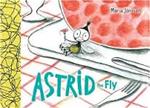 In this picture book published originally in Sweden, Astrid the fly relates a cautionary tale. Although she’s heard many a story from her relatives about the perils of flyswatters and vacuums and the mysterious disappearance of her uncle, her own experience is enough to keep a fly from wandering very far from home. After overindulging in Danish salami, Astrid experiences ghastly side effects, including vision loss and a low body temperature. Amusingly, her problems were not related to the food but to having been trapped in a refrigerator when someone moved the salami there. Her experience causes her to forego meat. The brightly colored watercolor and ink illustrations enhance the message that healthy lifestyle changes can occur, even on the basis of false evidence. The book is wryly funny because it is told from Astrid's misguided perspective and she ends up avoiding salami for the wrong reasons.
In this picture book published originally in Sweden, Astrid the fly relates a cautionary tale. Although she’s heard many a story from her relatives about the perils of flyswatters and vacuums and the mysterious disappearance of her uncle, her own experience is enough to keep a fly from wandering very far from home. After overindulging in Danish salami, Astrid experiences ghastly side effects, including vision loss and a low body temperature. Amusingly, her problems were not related to the food but to having been trapped in a refrigerator when someone moved the salami there. Her experience causes her to forego meat. The brightly colored watercolor and ink illustrations enhance the message that healthy lifestyle changes can occur, even on the basis of false evidence. The book is wryly funny because it is told from Astrid's misguided perspective and she ends up avoiding salami for the wrong reasons.
My Two Blankets. Irena Kobald. Illus. by Freya Blackwood. 2015. Houghton Mifflin Harcourt Books for Young Readers.
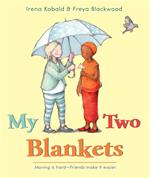 Cartwheel and her aunt flee the violence in their homeland. Their physical journey to safety is long and tiring, but the emotional journey is even more trying. Although they are safe in their new home, everything is unfamiliar and confusing, and Cartwheel feels disoriented and lonely until another girl in the park befriends her. Over time, she learns the language and is able to read, surrounding herself with a word blanket that is every bit as comforting as the blanket she uses to fend off the cold. The watercolor and oil paint illustrations and the text perfectly depict her feelings of isolation and uncertainty in a new place with unfamiliar words and practices; for instance, "When I went out, it was like standing under a waterfall of strange sounds. The waterfall was cold. It made me feel alone" (unpaged). This picture book, originally published in Australia, reminds readers eloquently of the power words have to diminish or enhance distance.
Cartwheel and her aunt flee the violence in their homeland. Their physical journey to safety is long and tiring, but the emotional journey is even more trying. Although they are safe in their new home, everything is unfamiliar and confusing, and Cartwheel feels disoriented and lonely until another girl in the park befriends her. Over time, she learns the language and is able to read, surrounding herself with a word blanket that is every bit as comforting as the blanket she uses to fend off the cold. The watercolor and oil paint illustrations and the text perfectly depict her feelings of isolation and uncertainty in a new place with unfamiliar words and practices; for instance, "When I went out, it was like standing under a waterfall of strange sounds. The waterfall was cold. It made me feel alone" (unpaged). This picture book, originally published in Australia, reminds readers eloquently of the power words have to diminish or enhance distance.
The White Book: A Minibombo Book. Silvia Borando, Elisabetta Pica, & Lorenzo Clerici. 2015. Candlewick.
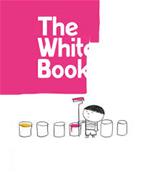 Originally published in Italy, this amusing wordless picture book shows a small boy busily painting the white walls of someone’s room in bright colors. Each time, as he deftly rolls the paint onto the left-hand page, to his delight, various animals emerge. Unfortunately, they seem to come to life only to disappear as they travel off the right-hand page. He's thrilled to see birds, fish, a dinosaur, an elephant, a giraffe, an anteater, and a dog and eagerly anticipates the fun they will bring into his world. By the time he sees a dog appear beneath the paint with which he is coating the walls, he knows not to expect too much. But this time, the dog decides to brighten his world by staying with him. Providing some humor to readers while also encouraging reflection, this picture book is funny and creative, and encourages readers to read between the lines to figure out what might be happening.
Originally published in Italy, this amusing wordless picture book shows a small boy busily painting the white walls of someone’s room in bright colors. Each time, as he deftly rolls the paint onto the left-hand page, to his delight, various animals emerge. Unfortunately, they seem to come to life only to disappear as they travel off the right-hand page. He's thrilled to see birds, fish, a dinosaur, an elephant, a giraffe, an anteater, and a dog and eagerly anticipates the fun they will bring into his world. By the time he sees a dog appear beneath the paint with which he is coating the walls, he knows not to expect too much. But this time, the dog decides to brighten his world by staying with him. Providing some humor to readers while also encouraging reflection, this picture book is funny and creative, and encourages readers to read between the lines to figure out what might be happening.
Ages 9–11
Our Heroes: How Kids Are Making a Difference. Janet Wilson. 2014. Second Story.
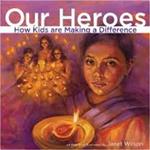 This inspiring Canadian book profiling 10 youngsters from across the globe who are making a difference in the world dispels the myth that the current generation lacks compassion or a desire to change the world. Not only may it prompt others to do their share to right some wrongs, but it also may remind many children to be grateful for what they have. Some of the projects involved raising money for the education of females, lobbying for a Children's Peace Forest, raising funds for soccer equipment, uniforms, and fields, aiding the homeless, and collecting donations to eradicate hunger. The issues these youngsters are tackling are not trivial matters but important ones. The book also contains several quotes about changing the world from these young world-changers as well as from famous men and women who also changed the world. In addition to the brief stories about these social activists, there are even more thumbnail sketches describing additional ways the next generation is making a difference before they’re even old enough to vote. This book would be a wonderful introduction to community service or to teach students empathy as well as encouraging them to feel empowered and able to make a change in their own small corners of the world.
This inspiring Canadian book profiling 10 youngsters from across the globe who are making a difference in the world dispels the myth that the current generation lacks compassion or a desire to change the world. Not only may it prompt others to do their share to right some wrongs, but it also may remind many children to be grateful for what they have. Some of the projects involved raising money for the education of females, lobbying for a Children's Peace Forest, raising funds for soccer equipment, uniforms, and fields, aiding the homeless, and collecting donations to eradicate hunger. The issues these youngsters are tackling are not trivial matters but important ones. The book also contains several quotes about changing the world from these young world-changers as well as from famous men and women who also changed the world. In addition to the brief stories about these social activists, there are even more thumbnail sketches describing additional ways the next generation is making a difference before they’re even old enough to vote. This book would be a wonderful introduction to community service or to teach students empathy as well as encouraging them to feel empowered and able to make a change in their own small corners of the world.
The World in a Second. Isabel Minhós Martins. (2015). Illus. by Bernardo Carvalho. Enchanted Lion.
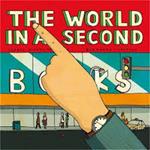 Thoughtful and thought-provoking text and large, colorful illustrations sprawling two pages take readers to 23 different stops throughout the world in one-second pauses. Beginning in Buenos Aires, Argentina, and ending in Florianopolis, Brazil, readers have the chance to see what is happening at the exact same point in time. There are moments of anxiety as a ship fights its way through treacherous waves, annoyance as a driver waits impatiently for a long line of traffic to move, loneliness as an elderly woman falls asleep in her bed, and even closure as a reader comes to the final pages of a book. Readers will be intrigued by the choice of seconds that are depicted here and fascinated by the stories hidden within each second. Because the last two pages show a woman flipping through the pages of this very book, teachers may want to explore metafictive techniques that question the line between the observer and the observed. Readers can use clues from the illustrations or the map to figure out exactly where each scene takes place. Originally published in Portugal, the book encourages reflection about the importance of a second in someone’s life.
Thoughtful and thought-provoking text and large, colorful illustrations sprawling two pages take readers to 23 different stops throughout the world in one-second pauses. Beginning in Buenos Aires, Argentina, and ending in Florianopolis, Brazil, readers have the chance to see what is happening at the exact same point in time. There are moments of anxiety as a ship fights its way through treacherous waves, annoyance as a driver waits impatiently for a long line of traffic to move, loneliness as an elderly woman falls asleep in her bed, and even closure as a reader comes to the final pages of a book. Readers will be intrigued by the choice of seconds that are depicted here and fascinated by the stories hidden within each second. Because the last two pages show a woman flipping through the pages of this very book, teachers may want to explore metafictive techniques that question the line between the observer and the observed. Readers can use clues from the illustrations or the map to figure out exactly where each scene takes place. Originally published in Portugal, the book encourages reflection about the importance of a second in someone’s life.
A Year in the Life of a Total and Complete Genius. Stacey Matson. 2015. Scholastic.
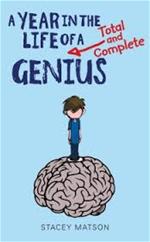 Seventh grader Arthur Bean has a lot more than school on his mind, and this book, published originally in Canada, provides insight into his unique way of thinking. A series of letters, e-mails, and journal entries written from October to June reveal both how Arthur is coping with the unexpected death of his mother and his inflated sense of self. There is little doubt in his mind that one day his writing will be just as celebrated as the works of Stephen King. But his overconfidence and arrogance mask deep pain and insecurity as well as the extreme writer’s block that prevents him from writing a story that will claim first prize in the school contest. His frustration leads to his making a very bad decision. Although parts of the book are hilarious, the humor masks the heavy issues with which Arthur and others are contending. The notes detailing Arthur’s unwilling tutoring sessions with the hated Robbie Zack, those from Ms. Whitehead, and e-mails from a female classmate interested in writing will prompt readers to shake their heads in dismay as they watch Arthur paint himself into a corner more than once. What remains to be seen is whether he can paint himself out of a mess of his own making.
Seventh grader Arthur Bean has a lot more than school on his mind, and this book, published originally in Canada, provides insight into his unique way of thinking. A series of letters, e-mails, and journal entries written from October to June reveal both how Arthur is coping with the unexpected death of his mother and his inflated sense of self. There is little doubt in his mind that one day his writing will be just as celebrated as the works of Stephen King. But his overconfidence and arrogance mask deep pain and insecurity as well as the extreme writer’s block that prevents him from writing a story that will claim first prize in the school contest. His frustration leads to his making a very bad decision. Although parts of the book are hilarious, the humor masks the heavy issues with which Arthur and others are contending. The notes detailing Arthur’s unwilling tutoring sessions with the hated Robbie Zack, those from Ms. Whitehead, and e-mails from a female classmate interested in writing will prompt readers to shake their heads in dismay as they watch Arthur paint himself into a corner more than once. What remains to be seen is whether he can paint himself out of a mess of his own making.
Ages 12–14
Moletown. Torben Kuhlmann. 2015. NorthSouth.
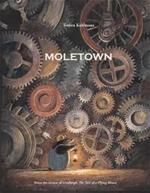 This talented author/illustrator from Germany impressed critics and readers alike with Lindbergh: The Tale of a Flying Mouse (2014), and this follow-up is equally impressive. In this almost-wordless picture book, one mole moves underground, leaving the lush greenery of the outside world behind, and then slowly, things get out of hand. Industrialization, progress, and damaging environmental practices eventually take their toll on Moletown, leaving its residents with only a very small patch of land that has not spoiled by the land’s exploitation. Clearly, while progress has its place, it also comes with a price, making this a humorous but stark reminder of what may lie ahead for all of us. The illustrations are filled with exhausted workers, congested streets, and air that has become increasingly hard to breathe. This book should surely serve as a powerful reminder of the importance of careful stewardship toward the good, green Earth and a consideration of the environmental choices being made. If this and his earlier publication are any indication of this artist’s potential, waiting to see more will be hard.
This talented author/illustrator from Germany impressed critics and readers alike with Lindbergh: The Tale of a Flying Mouse (2014), and this follow-up is equally impressive. In this almost-wordless picture book, one mole moves underground, leaving the lush greenery of the outside world behind, and then slowly, things get out of hand. Industrialization, progress, and damaging environmental practices eventually take their toll on Moletown, leaving its residents with only a very small patch of land that has not spoiled by the land’s exploitation. Clearly, while progress has its place, it also comes with a price, making this a humorous but stark reminder of what may lie ahead for all of us. The illustrations are filled with exhausted workers, congested streets, and air that has become increasingly hard to breathe. This book should surely serve as a powerful reminder of the importance of careful stewardship toward the good, green Earth and a consideration of the environmental choices being made. If this and his earlier publication are any indication of this artist’s potential, waiting to see more will be hard.
Some Things I’ve Lost. Cybele Young. 2015. Groundwood.
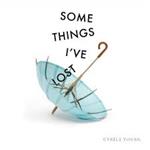 Although it is short in length, this very different book from Canada is not short in ideas. Without a doubt, it will encourage readers to reconsider how they regard commonplace objects in their lives or even their reaction to losing something. Although it is frustrating to lose or temporarily misplace objects, the author/illustrator wonders what might happen to them after they’re lost. With complicated and extraordinarily detailed paper sculptures, she unravels the 12 different objects in the book to reveal what might be hiding inside an umbrella, a wristwatch, and a lawn chair, among others, as well as relating where they were last seen. The book’s pages unfold to show what this visual artist sees within each of those common objects, objects to which most individuals would never give a second thought. Perhaps there is more to each of them than is visible to the naked eye, and perhaps we should look more closely and more imaginatively to the world around us. This book would provide marvelous inspiration for a creative writing or an art class, as the illustrations are incredibly detailed and move out in many different directions.
Although it is short in length, this very different book from Canada is not short in ideas. Without a doubt, it will encourage readers to reconsider how they regard commonplace objects in their lives or even their reaction to losing something. Although it is frustrating to lose or temporarily misplace objects, the author/illustrator wonders what might happen to them after they’re lost. With complicated and extraordinarily detailed paper sculptures, she unravels the 12 different objects in the book to reveal what might be hiding inside an umbrella, a wristwatch, and a lawn chair, among others, as well as relating where they were last seen. The book’s pages unfold to show what this visual artist sees within each of those common objects, objects to which most individuals would never give a second thought. Perhaps there is more to each of them than is visible to the naked eye, and perhaps we should look more closely and more imaginatively to the world around us. This book would provide marvelous inspiration for a creative writing or an art class, as the illustrations are incredibly detailed and move out in many different directions.
Ages 15+
A Prince Without a Kingdom. Timothee de Fombelle. 2015. Candlewick.
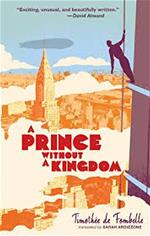 Fans of this book’s predecessor, Vango: Between Sky and Earth (2014), will find that it shines even more brilliantly paired with this concluding volume. The same elements that made the first title so appealing are here: espionage, a dash of romance, intrigue, complicated characters, exotic locations, misplaced loyalty, revenge, heroics, and travel from one continent to another. The list of characters provided at the start of the book is helpful because there are several characters in the books who appear briefly, disappear, and then appear again. Although the first book offered only shadowy hints of Vango’s past and his identity, this one solves that mystery satisfactorily and places it within the context of the Russian Revolution and the Holocaust. Teen readers will be mesmerized by the intrigue while rooting for true love to find a way and a happy ending for several of the characters. Often, only the barest of margins separates the characters from joy or disaster. Clearly, desperate times call for desperate actions and force otherwise good individuals to behave in ways they wouldn’t have otherwise. Originally published in France, this book certainly gives a whole new meaning to the term "breathless" as Vango zips from place to place and one dangerous situation after another and his desire for revenge and some answers about his past have been satisfied.
Fans of this book’s predecessor, Vango: Between Sky and Earth (2014), will find that it shines even more brilliantly paired with this concluding volume. The same elements that made the first title so appealing are here: espionage, a dash of romance, intrigue, complicated characters, exotic locations, misplaced loyalty, revenge, heroics, and travel from one continent to another. The list of characters provided at the start of the book is helpful because there are several characters in the books who appear briefly, disappear, and then appear again. Although the first book offered only shadowy hints of Vango’s past and his identity, this one solves that mystery satisfactorily and places it within the context of the Russian Revolution and the Holocaust. Teen readers will be mesmerized by the intrigue while rooting for true love to find a way and a happy ending for several of the characters. Often, only the barest of margins separates the characters from joy or disaster. Clearly, desperate times call for desperate actions and force otherwise good individuals to behave in ways they wouldn’t have otherwise. Originally published in France, this book certainly gives a whole new meaning to the term "breathless" as Vango zips from place to place and one dangerous situation after another and his desire for revenge and some answers about his past have been satisfied.
Speak a Word for Freedom: Women Against Slavery. Janet Willen & Marjorie Gann. 2015. Random House/Tundra.
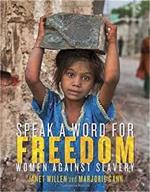 Relying on primary documentation when available in addition to secondary sources and interviews, the authors have assembled an impressive collection of 14 female abolitionists who dared to call to question the continued use of slaves to perform tasks as well as reminding those around them of the immorality of owning another person. Starting in 1781 with Elizabeth Freeman, who sued her master on the grounds that slavery was illegal in Massachusetts, and concluding with Nina Smith, the director of GoodWeave, who works to end child slavery and ensure ethical trade, the book provides information about each woman and her work to eradicate slavery. Although some of these activists such as Harriet Tubman and Harriet Beecher Stowe will be familiar figures, others who are less famous have still cut a mighty swath for equity and against slavery and deserve acknowledgment.
Relying on primary documentation when available in addition to secondary sources and interviews, the authors have assembled an impressive collection of 14 female abolitionists who dared to call to question the continued use of slaves to perform tasks as well as reminding those around them of the immorality of owning another person. Starting in 1781 with Elizabeth Freeman, who sued her master on the grounds that slavery was illegal in Massachusetts, and concluding with Nina Smith, the director of GoodWeave, who works to end child slavery and ensure ethical trade, the book provides information about each woman and her work to eradicate slavery. Although some of these activists such as Harriet Tubman and Harriet Beecher Stowe will be familiar figures, others who are less famous have still cut a mighty swath for equity and against slavery and deserve acknowledgment.
Strange Light Afar: Tales of the Supernatural From Old Japan. Rui Umezawa. 2015. Illus. by Mikiko Fujita. Groundwood.
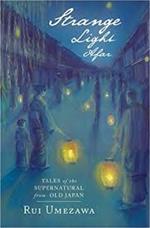 Eight beautifully written stories filled with supernatural elements and in-depth character development are contained in this book. Based on familiar Japanese folk tales, the kernels of the stories are simplified into one-word titles for each story and enable readers to explore themes concerning greed, desire, honor, and betrayal, and the reasons for the foolish actions of humans. Choosing favorites out of such an outstanding collection isn’t easy, but many readers will be horrified by "Envy," in which a brother who is jealous of the fortunes of his own brother shows just how envious he is and what that envy brings him to do in chilling fashion. Also notable is "Betrayal," in which new bridegroom Tamiya isn’t content with his lovely bride Oiwa but wants even more than what he has and plots to kill her. Perfect for a Halloween night or an evening spent by a campfire, these stories are captivating. There isn't a single one that will fail to hold readers’ interests.
Eight beautifully written stories filled with supernatural elements and in-depth character development are contained in this book. Based on familiar Japanese folk tales, the kernels of the stories are simplified into one-word titles for each story and enable readers to explore themes concerning greed, desire, honor, and betrayal, and the reasons for the foolish actions of humans. Choosing favorites out of such an outstanding collection isn’t easy, but many readers will be horrified by "Envy," in which a brother who is jealous of the fortunes of his own brother shows just how envious he is and what that envy brings him to do in chilling fashion. Also notable is "Betrayal," in which new bridegroom Tamiya isn’t content with his lovely bride Oiwa but wants even more than what he has and plots to kill her. Perfect for a Halloween night or an evening spent by a campfire, these stories are captivating. There isn't a single one that will fail to hold readers’ interests.
Barbara A. Ward teaches graduate and undergraduate courses in literacy at Washington State University, Pullman. She spent 25 years teaching in the public schools of New Orleans, where she worked with students at every grade level, from kindergarten through high school as well as several ability levels. She is certified in elementary education, English education, and gifted education. She holds a bachelor's in communications and a master's in English Education from the University of Tennessee and a PhD in Curriculum and Instruction from the University of New Orleans.
These reviews are submitted by members of the International Reading Association's Children's Literature and Reading Special Interest Group (CL/R SIG) and are published weekly on Literacy Daily
.